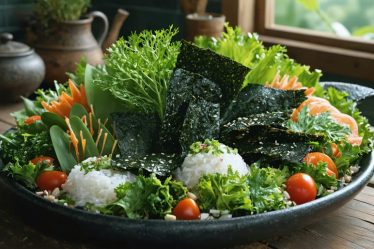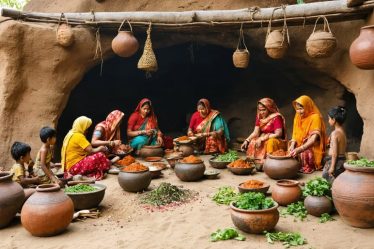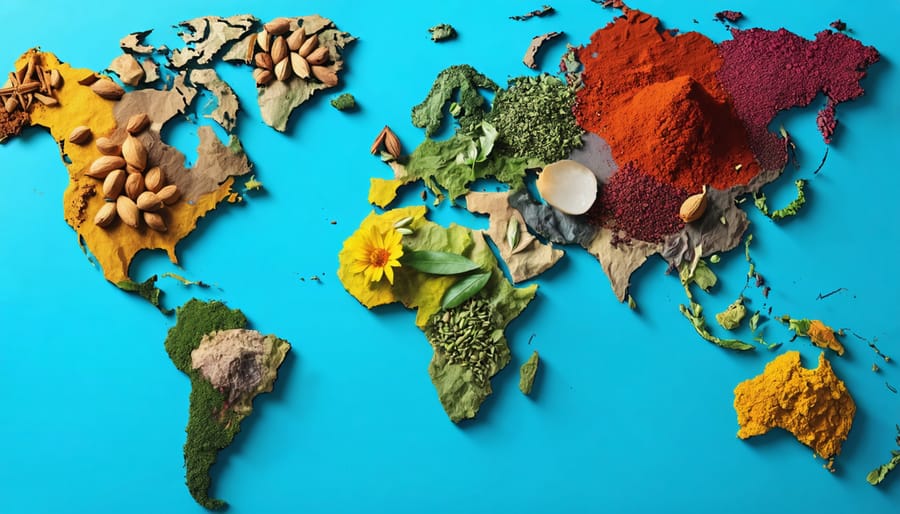
Step into a world where every kitchen cabinet holds the potential for culinary adventure. From Morocco’s complex ras el hanout to Japan’s umami-rich shichimi togarashi, spice blends are the heart and soul of cultural food traditions that have shaped cuisines for centuries. These carefully crafted combinations don’t just add flavor – they tell stories of trade routes, family ceremonies, and ancient wisdom passed down through generations.
Think of spice blends as ready-made poetry for your palate: Ethiopian berbere brings warmth and complexity to stews, Indian garam masala transforms ordinary rice into a fragrant feast, and Chinese five-spice powder adds mysterious depth to both savory and sweet dishes. Each blend is a testament to human ingenuity, combining local ingredients with imported treasures to create something greater than the sum of its parts.
Whether you’re a curious home cook or a seasoned chef, understanding these global spice combinations opens doors to authentic cooking techniques while offering a glimpse into the kitchens of countless cultures. Let’s explore how these aromatic mixtures can transform your everyday cooking into an extraordinary culinary journey.
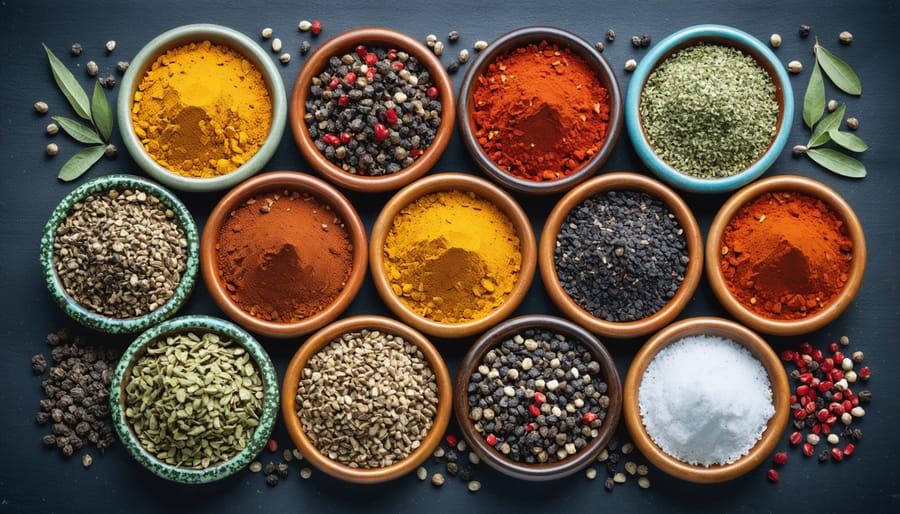
Middle Eastern Magic: The Heart of Spice Culture
Za’atar: The Breakfast Table Storyteller
Every morning across the Middle East, breakfast tables come alive with the aromatic embrace of za’atar, a beloved spice blend that’s more than just seasoning – it’s a cherished tradition passed down through generations. As someone who discovered this magical mixture during my own global culinary adventures, I’ve learned that each family’s za’atar tells its own story.
This ancient blend traditionally combines wild thyme, sumac, sesame seeds, and sea salt, though regional variations might include oregano, marjoram, or other herbs. The result is a harmonious mix that’s simultaneously earthy, tangy, and nutty. In Lebanon, you’ll find mothers dipping fresh flatbread in olive oil and za’atar for their children’s breakfast, while in Jordan, it’s sprinkled generously over labneh (strained yogurt) for a morning treat.
Beyond its delicious flavor, za’atar holds deep cultural significance. Traditional wisdom suggests it enhances memory and energy levels, which is why students often start their day with za’atar-topped manakish before important exams. The act of mixing and sharing za’atar brings families together, with recipes carefully guarded and passed down as precious heirlooms.
Whether you’re sprinkling it over your morning eggs, mixing it into olive oil for bread dipping, or using it to elevate roasted vegetables, za’atar adds both flavor and a connection to centuries of Middle Eastern culinary tradition.
Baharat: The Seven-Spice Symphony
Every time I open my jar of baharat, the warm, sweet-spicy aroma instantly transports me to the bustling souks of the Middle East. This beloved seven-spice blend is the heart and soul of Middle Eastern cooking, combining black pepper, cumin, coriander, cinnamon, cloves, cardamom, and nutmeg in perfect harmony.
In traditional Middle Eastern homes, baharat is as essential as salt and pepper are in Western kitchens. I learned from my Lebanese neighbor that every family has their own special ratio of spices, passed down through generations like a cherished secret. Some add paprika for color, while others might include a pinch of saffron for special occasions.
What makes baharat truly magical is its versatility. It’s the secret ingredient that gives depth to everything from hearty meat stews and rice dishes to grilled vegetables. I love sprinkling it on roasted chicken before cooking, where it creates an irresistibly fragrant crust. For vegetarian dishes, try adding a teaspoon to lentil soup or roasted butternut squash – it adds warmth without overwhelming the natural flavors.
Beyond its culinary uses, baharat holds cultural significance as a symbol of hospitality. In many Middle Eastern households, serving guests food seasoned with your finest baharat blend is a gesture of welcome and respect. This tradition of sharing flavors continues to bring people together, one aromatic dish at a time.
Indian Spice Traditions: More Than Just Curry

Garam Masala: The Royal Blend
Every Indian household has its own secret garam masala recipe, passed down through generations like precious family heirlooms. I still remember watching my friend’s grandmother carefully toasting whole spices in her tiny Mumbai kitchen, the aromatic dance of cardamom, cinnamon, and cloves filling the air with warmth and nostalgia.
While “garam masala” literally translates to “hot spice blend,” it’s not about heat from chilies but rather the warming properties of its ingredients. The blend varies dramatically across India’s diverse regions – Northern versions typically feature more cardamom and cinnamon, while Southern variations might include more star anise and fennel seeds.
In Punjab, you’ll find a robust blend heavy on cumin and coriander, perfect for hearty curries. Maharashtra’s version often includes more coconut and sesame seeds, while Bengali garam masala might surprise you with its subtle hint of nutmeg. Some families add dried rose petals for an extra touch of elegance, a nod to the blend’s royal Mughal heritage.
Beyond its culinary role, garam masala holds deep cultural significance in Indian ceremonies and celebrations. It’s considered auspicious in many rituals, and gifting homemade garam masala to newlyweds is still a beautiful tradition in some communities – a symbolic way of passing down love through flavors.
Whether store-bought or homemade, this aromatic blend has the power to transform everyday dishes into memorable feasts.
Chaat Masala: Street Food’s Secret Weapon
Walking through any bustling Indian street market, you’ll notice a distinctive tangy aroma that makes your mouth water instantly – that’s the magic of chaat masala at work! This beloved spice blend is the not-so-secret ingredient that gives Indian street food its irresistible flavor, transforming simple snacks into crave-worthy treats.
As a home cook who fell in love with Indian cuisine, I’ve learned that chaat masala is like fairy dust for food. This magical mixture typically combines amchur (dried mango powder), black salt (kala namak), cumin, coriander, black pepper, and other spices to create a perfectly balanced sweet, sour, and savory profile. The black salt gives it that distinctive sulfurous tang that’s impossible to replicate with any other ingredient.
What makes chaat masala truly special is its versatility. While it’s traditionally sprinkled over street food favorites like samosas, bhel puri, and fruit chaat, it’s also wonderful on everyday items. Try a pinch on fresh cut fruit, roasted corn, or even your morning eggs – trust me, it’s a game-changer! I’ve even seen creative food vendors using it to rim glasses for unique cocktails.
The beauty of chaat masala lies in how it brings people together. In India, street food stalls become community gathering spots, with vendors skillfully sprinkling this magical blend while chatting with regular customers, creating not just meals but memories.
Mediterranean Memories in Spices
Herbs de Provence: The French Connection
Picture yourself strolling through a sun-drenched Provençal market, where the fragrant aroma of dried herbs mingles with the warm Mediterranean breeze. This enchanting scene is exactly what Herbs de Provence captures in a single blend. Born in the picturesque southern French countryside, this iconic mixture typically combines savory, marjoram, thyme, oregano, and the region’s crown jewel – lavender.
While local families have been mixing these herbs for generations, the commercial blend we know today gained popularity in the 1970s, bringing a taste of French countryside cooking to kitchens worldwide. Each family’s recipe might vary slightly, but the heart of the blend remains rooted in the wild herbs that flourish along Provence’s limestone hills.
I love sprinkling this versatile blend over roasted vegetables, particularly eggplant and tomatoes, or using it to elevate a simple grilled chicken. It’s also wonderful in marinades or stirred into olive oil for bread dipping. The subtle floral notes of lavender alongside the earthy herbs create a harmony that’s distinctly French and impossibly elegant.
For the most authentic experience, look for blends that feature herbs grown in Provence itself – the unique terroir adds a special magic that’s worth seeking out.
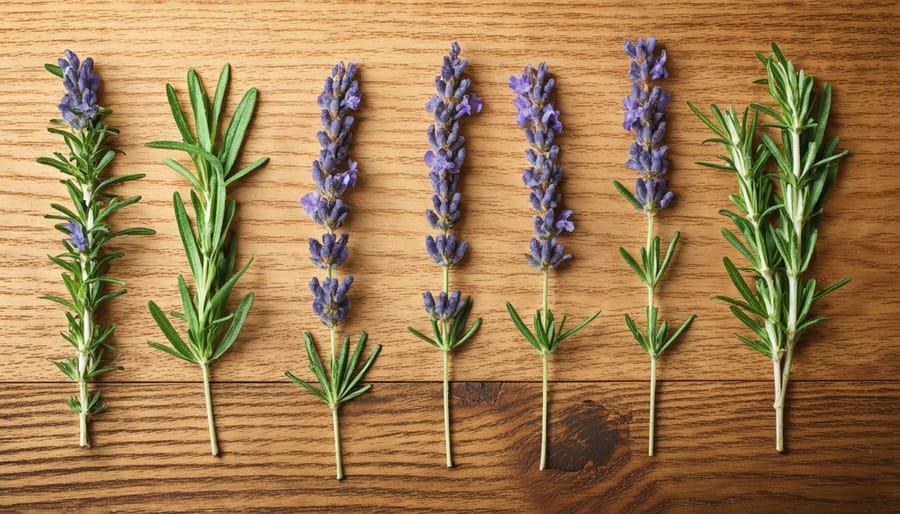
Greek Seasoning: Ancient Wisdom in Every Pinch
When I think of Greek seasoning, I’m instantly transported to sun-drenched Mediterranean hillsides dotted with wild oregano and thyme. This aromatic blend, perfected over generations, captures the essence of Greek cuisine in every sprinkle. The foundation typically includes oregano, garlic, onion, and basil, with many families adding their secret touch of mint or dill.
What makes Greek seasoning truly special is its versatility. Whether you’re grilling souvlaki, roasting vegetables, or preparing a traditional Greek salad, this blend adds that authentic Mediterranean magic. I love how a pinch can transform ordinary roasted potatoes into a taverna-worthy side dish!
The ancient Greeks believed in the healing properties of herbs, using them not just for flavor but for wellness. Today’s Greek seasoning carries this wisdom forward, combining herbs known for their digestive benefits and antioxidant properties. My Greek neighbor always says, “Good food is good medicine,” and this seasoning blend perfectly embodies that philosophy.
For the best results, crush the dried herbs between your fingers before using them – this releases their essential oils and intensifies their flavor, just as Greek yiayias (grandmothers) have done for centuries.
Modern Kitchen Applications
Bringing global spice blends into your modern kitchen doesn’t have to be intimidating – in fact, it’s one of the easiest ways to transform everyday cooking into an exciting culinary adventure. I remember the first time I experimented with Moroccan ras el hanout in a simple roasted chicken dish; my family couldn’t believe such a familiar meal could taste so extraordinary!
Start by incorporating these blends gradually into dishes you already know and love. Za’atar can elevate your morning avocado toast, while garam masala can add depth to your favorite vegetable soup. When you approach cooking with these spices as part of your mindful cooking techniques, you’ll discover endless possibilities for creativity.
Here are some practical ways to use global spice blends in your daily cooking:
Mix them into marinades: Combine Chinese five-spice with olive oil and honey for an incredible chicken or tofu marinade.
Spice up your roasted vegetables: Toss sweet potatoes or cauliflower with berbere before roasting for an Ethiopian-inspired side dish.
Enhance your breakfast: Sprinkle dukkah over your eggs or blend herbs de Provence into your morning omelet.
Create unique dips: Mix sumac or za’atar with Greek yogurt for a quick and flavorful dip.
Don’t be afraid to experiment beyond traditional uses. I’ve found that Japanese togarashi makes an incredible seasoning for popcorn, while baharat can add wonderful complexity to chocolate cookies. The key is starting with small amounts and adjusting to your taste preferences.
Storage tip: Keep your spice blends in airtight containers away from direct sunlight and heat. Label them with the date of purchase or mixing, and try to use them within six months for the best flavor. I like to keep my most-used blends in small jars near my cooking area for easy access.
For beginners, I recommend starting with three versatile blends: an Italian herb mixture for Mediterranean dishes, garam masala for Indian-inspired cooking, and za’atar for Middle Eastern flavors. These will give you a solid foundation to explore global cuisines while building your confidence with new flavors.
Remember, there’s no right or wrong way to use these spice blends – let your creativity and taste buds guide you. Some of the most delicious discoveries happen when we dare to mix traditions and create something uniquely our own.
As I stir my favorite curry powder into a simmering pot of lentils, I’m struck by how these aromatic spice blends connect us across time and continents. Each blend tells a story – of trade routes traversed, of family recipes whispered between generations, and of cultures meeting and melding in magnificent ways.
In our fast-paced world of convenience foods and instant meals, these traditional spice blends serve as delicious reminders of our shared human heritage. They’re more than just flavor enhancers; they’re living history in our kitchen cabinets. When we take the time to toast whole spices, grind them by hand, and create these time-honored blends, we’re not just cooking – we’re keeping centuries-old traditions alive.
I’ve found that sharing these spice traditions with friends and family creates beautiful moments of connection. Whether it’s teaching my daughter how to blend her first garam masala or swapping za’atar recipes with neighbors, these experiences strengthen our community bonds and cultural understanding.
Let’s embrace these aromatic treasures as bridges between past and present, between cultures and communities. By incorporating traditional spice blends into our daily cooking, we ensure these culinary landmarks continue to enchant and inspire future generations of home cooks. After all, every shake of berbere or pinch of herbes de Provence carries within it the wisdom and creativity of countless cooks who came before us.


